| Wolverhampton In point of size and manufacturing
importance, Wolverhampton easily holds premier position
among the chief towns of Staffordshire.
Its growth during the present century
has been rapid, as a glance at the census returns will
show:- In 1821, the population was 18,380; in 1831, 24,732;
in 1841, 36,382; in 1851, 49,989; in 1861, 60,858; in 1871,
68,279; in 1881, 75,738; and in 1891, 82,620. It will thus
be seen that its progress in population has been steady and
substantial, whilst as regards its advance in social,
industrial, educational, and administrative directions, no
town in the kingdom can show better results.
|
|

The Town Hall. |
The chief public buildings: Town Hall,
Art Gallery and Museum, Library, Hospital, Post Office,
Exchange and Markets, Park, etc., all bear evidence of the
progressive spirit of its inhabitants, and on the other
hand, its philanthropic institutions reflect the highest
credit upon the generosity of its more wealthy inhabitants. |
| Being an essentially manufacturing
town, possessing localities of somewhat grimy aspect,
particularly as seen in travelling through on the railways,
many people for want of closer acquaintance with the place
imagine it to be a typical "black country" town of
altogether unprepossessing appearance and character, but
such is by no means the case, Wolverhampton has really
beautiful suburbs, and its main streets are clean and highly
attractive. It may be said to lie on the fringe of the black
country, partaking somewhat of the character of this
renowned neighbourhood on the one side, but embracing
charming country in extensive residential districts on the
other. |
| Wolverhampton was known to the Saxons
as Hanton or Hamton. It became, in 996, the site of a
college for a dean and several prebendaries or secular
canons, founded by Wu1fruna, sister of King Edgar; and it
then took the name of Wulfrunis-Hamton, afterwards corrupted
into Wolverhampton.
Tradition points to the town being known
about 650, in the reign of Wulfhere, King of Mercia. In
Doomsday Book, the name given is Wulfronhampton. |
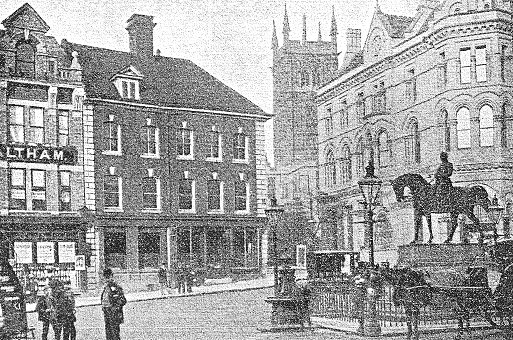
Queen Square. |
|
Henry III granted a charter for a
weekly market and annual fair in 1258; afterwards, Edward
III confirmed this charter and made other concessions. During the Civil War, the town was
occupied by the Parliamentary forces, and in the same year,
1642, Charles I visited it. The same monarch was here again
in 1645 after his defeat at Naseby.
Wolverhampton made little figure in the
middle ages; but it rose eventually into high consequence,
and made rapid increase, in connection with vast mineral
wealth in its immediate vicinity. The Parliamentary Borough of
Wolverhampton was created by the Reform Act of 1832. The
Municipal Borough was incorporated by Royal Charter, granted
in 1847, under the provisions of the Municipal Reform Act of
1835. |
|
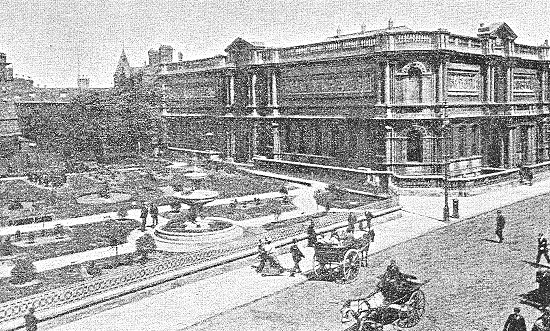
The Art Gallery and St. Peter's
Gardens. |
The Town Council consists of a mayor,
twelve aldermen, and thirty six councillors; and the borough
had a commission of the peace granted in 1849.
G. B.
Thorneycroft, Esq., was the first mayor. Markets are held on
Wednesday and Saturday.
|
| Wolverhampton is 122 miles north-west
by west of London; 14 miles from Birmingham, 16 miles south
of Stafford, 16 miles west south-west of Lichfield, 6 miles
west of Walsall, and about 33 miles south of centre of the
Pottery district. Three of the principal railway systems
connect with the town, namely: the London and North Western,
Great Western, and Midland lines. The town has thus easy
access with all parts of the kingdom; besides which there is
canal communication of an extensive character.
Industries
Wolverhampton is a chief centre of iron
manufacture, and one of its oldest industries is that of
lock manufacturing, which dates back several centuries, and
for which the town has always been conspicuously noted.
The production of every description of
tinned, japanned, galvanized, and enamelled ware,
wrought-iron goods, gates, railings, fencing, trunks, fancy
steel goods, nails, horse shoes, gas fittings and tubes of
all kinds, finds employment for a great many hands, and
there are also extensive engineering and iron foundry
establishments, boot and shoe manufactories and leather
works, agricultural implement works, wire works, varnish and
colour manufactories, large saw mills and cooperages,
chemical works, roperies, maltings and breweries, mineral
water factories, flour mills, cabinet and pianoforte
manufactories, etc., etc.
|
|
We have yet to mention the enormous
development of the cycle industry during recent years; this
trade has increased by leaps and bounds, many new firms
having sprung into existence, and a good number have reached
most eminent positions.
Thousands of hands are employed in the
manufacture of cycles and component parts, and the town now
enjoys world-wide fame for its high-grade productions.
|
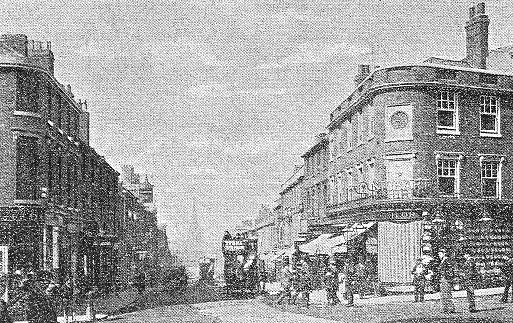
Darlington Street. |
| Wolverhampton-made goods find their way
to all quarters of the globe, and hold their own for quality
and utility in the very best markets.
Notable Buildings etc.
The Town Hall in North Street is a
handsome building in the Italian style of architecture, and
was built at a cost of £20,000. It comprises sessions and
magistrates courts, council chambers, municipal offices,
committee rooms, mayor’s parlour, recorder's rooms, etc.,
etc.
The Exchange, adjoining the Market
Place, was built in 1851, at a cost of £ 15,000. The main
room is 120 feet long, and 50 feet wide. The Agricultural Hall, Snow Hill,
covers an area of 1,200 square yards. It was opened in 1863,
at a cost of £6,000. The Market Hall in North Street cost
£30,000 in 1853.
The Art Gallery and School of Art in
New Lichfield Street, is a handsome edifice, occupying a
splendid position, and is an institution of which the town
has reason to be proud. The site was devoted to the purpose
by the Corporation, and the building, together with many
valuable gifts, were given by the late Philip Horsman, Esq.
A fine collection of oil paintings and water colours were
presented by the late Mrs. Sydney Cartwright.
The Free Library in Garrick Street
comprises library, reading rooms, lecture hall, science
classrooms, etc.
|
|
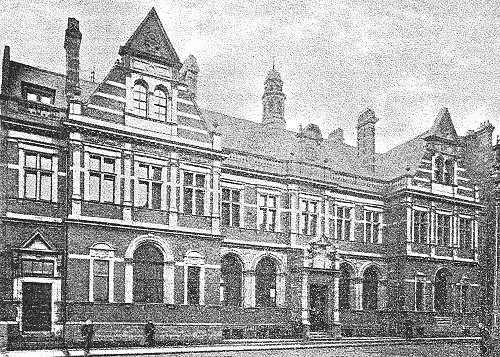
The new Post Office. |
The beautiful Public Park is 50 acres
in extent, contains two lakes, an ornamental waterfall, a
fine conservatory, two drinking fountains, bandstand, clock,
etc. One of the largest floral fètes in the kingdom is held
in the park annually in July.
The New Post Office in Lichfield
Street, opened March 29, 1897, is a spacious edifice of
imposing appearance, and a little distance from this is the
Grand Theatre, a building likewise conspicuous and
attractive in architectural features.
|
|
The Prince Consort Statue in Queen
Square was erected by public subscription, and inaugurated
by Her Majesty Queen Victoria, in 1866.
Wolverhampton is behind no other town
in the Midlands in the number and excellence of its
scholastic, benevolent, and charitable institutions. The
Wolverhampton and Staffordshire General Hospital, Cleveland
Road, contains 225 beds. It was erected by subscription. The Wolverhampton Eye Infirmary,
Compton Road, was established in 1881, and is supported by
voluntary contributions. The Wolverhampton Borough Hospital,
Green Lane, was opened in 1885, and there is a Women's
Hospital at Chapel Ash.
The Wolverhampton Orphan Asylum at
Goldthorn Hill, was founded by Mr. John Lees, in 1850. It
has been enlarged since, and its entire cost has exceeded
£25,000. There is accommodation for about 400 boys and
girls. There are many lesser known, but useful and
benevolent institutions.
Churches, Chapels etc.
|
| St. Peter's (formerly Collegiate, and
dedicated to St. Mary, until the reign of Henry VIII), is a
stone edifice rebuilt in 1864-5, and since enlarged.
This is the church supposed to have
been founded by Wulfruna, but there is no part of the
existing edifice older than the thirteenth century. |
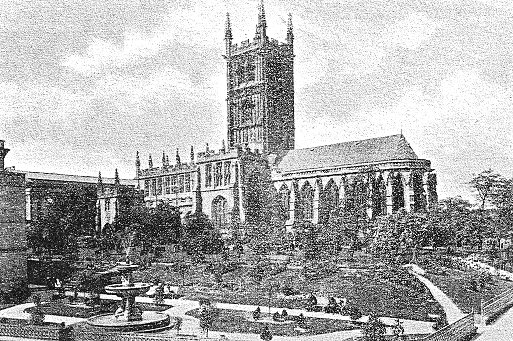
St. Peter's Church. |
|
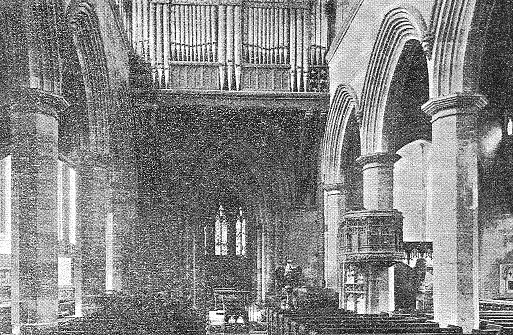
The interior of St. Peter's Church. |
The
other principal churches are All Saints', in Steelhouse
Lane; St. Jude's, Tettenhall Road; St. Paul's, Penn Road;
St. Mary's, Stafford Street; St. Matthew's, Walsall Street;
St. Mark's, Chapel Ash; St. Luke's, Blakenhall; Christ
Church, Waterloo Road; St. Andrew's, Whitmore Reans; St.
George's, Cleveland Road; St. James', Horseley
Fields; and St. John's, St. John's Square. |
| The Roman Catholics,
Congregationalists, Wesleyans, Primitive Methodists,
Baptists, Methodist New Connexion, Presbyterians, and Welsh
Presbyterians have large and commodious places of worships
in various parts of the town. |
|
Parliamentary representatives:
West
Division (including part of Bilston), representative - Sir
Alfred Hickman, M.P., D.L., J .P.
East Division (includes
Willenhall and Wednesfield, etc), Representative - Rt. Hon.
Sir H. H. Fowler, G.C.S.I., M.P., J.P.
South Division
(comprises Sedgley, and part of Bilston) Representative -
Rt. Hon. C. P. Villiers, M.P.
|
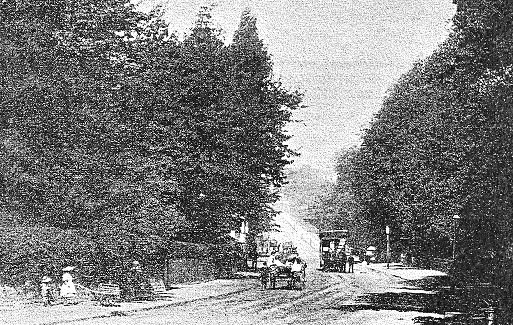
A horse-drawn tram at the Newbridge
terminus. |
|
Wolverhampton Town Council
Stephen Craddock, Esq., Mayor. St.
Peter's Ward: Alderman T. V. Jackson, J.P., Councillors R.
A. Willcock, C. P. Plant, W. Gough Allen.
| St. Mary's Ward: Alderman B. F.
Williams, Councillors L. W. Hodson, B. Smith, J. G. Hodgson.
|
| St. James' Ward: Alderman Francis D.
Gibbons, J.P., Councillors T. Beckett, W. H. Edwards, Price
Lewis. |
| St. Matthew's Ward: Alderman Joseph
Jones, J.P., Councillors E. Bull, J. Lawrence, W. Shepherd.
|
| St. George's Ward: Alderman S. Theodore
Mander, .JP., Councillors E. C. Pratt, T. D. Greensill, F.
Parkyn. |
| St. John's Ward: Alderman W. H. Jones,
J.P., Councillors J. W. Hamp, L. Johnson, R. R. Rhodes. |
| Blakenhall Ward: Alderman J. Saunders,
J.P., Councillors F. T. Langley, R. Stroud, Jeremiah Mason.
|
| Graiseley Ward: Alderman H. C. Owen,
Councillors James Stevenson, R. E. W. Berrington, Evan
Evans. |
| Merridale Ward: Alderman J. Marston,
J.P., Councillors T. F. Waterhouse, A. Weaver, B. Stanton. |
| St. Mark's Ward: Alderman S. Craddock,
Councillors E. Blakemore, H. Pinson, Dr. F. Edge. |
| Park Ward: Alderman C. T. Mander, J.P.,
Councillors W. G. Sherwood, E. D. Crane, H. W. Ash. |
| Dunstall Ward: Alderman John Annan,
J.P., Councillors A. McBean, F. Evans, C. H. Cousins, J.P. |
| |
| Corporate Officials, etc.: Town Clerk,
Horatio Brevitt; Chief Constable, Capt. Burnett; Water
Engineer, E. A. B. Woodward; Borough Engineer and Surveyor,
J. W. Bradley; Medical Officer of Health, Dr. Henry Malet;
Borough Analyst, E. W. T. Jones, F.I.C.; Borough Accountant,
W. Howell; Inspector of Nuisances, S. Blanton;
Superintendent of Markets, C. Dawson. Recorder, F. A.
Bosanquet, Q.C., London. Clerk of the Peace, Horatio Brevitt.
Borough Coroner, W. H. Phillips. Borough Magistrates Clerk,
E. H. Thorne. Offices, Town Hall. Stipendary Magistrate, N.
C. A. Neville. Clerk, W. A. Green. Offices, Corporation
Street. County Court Judge, His Honour Judge Griffith.
Official Receiver E. Pritchard, St. Peter's Close. |
| |
| Wolverhampton Board of Guardians:
Chairman, Frederick William Plant, Esq., C.C., Wellington
Road, Bilston. Vice-Chairman, Dr. James Yeomans Totherick,
Park Dale, Wolverhampton. Members: Bilston - Mr. J. W.
Sankey, Mrs. Reeves, Mr. W. Blair, Mr. F. W. Plant, Mr. T.
Harris. |
|
Heath Town - Mr. J. Cope.
|
| Short Heath - Rev. G. W. Johnson. |
| Wednesfield - Mr. J. Hyde, Mr. W. H.
Pritchard. |
| Willenhall - Rev. W. L. Ward, Mr. I.
Pedley, Mr. H. Wolverson. |
| Wolverhampton - Mr. R. Lowe, Mr. T. H.
Sawyers, Mrs. E. Hatton, Mr. F. Price, Mr. Wm. Dilke, Mr. T.
Norbury, Rev. J. M. J. Fletcher, Dr. J. Y. Totherick, Mr. T.
D. Greensill, Mrs. A. Dunkley, Mr. P. O'Kane, Mr. W.
Shepherd, Mr. H. J ones, Mr. Benjamin Williams, Mr. G. B.
Mitchell, Mr. C. Boyes, Mr. H. Moreton, Mr. W. Price. |
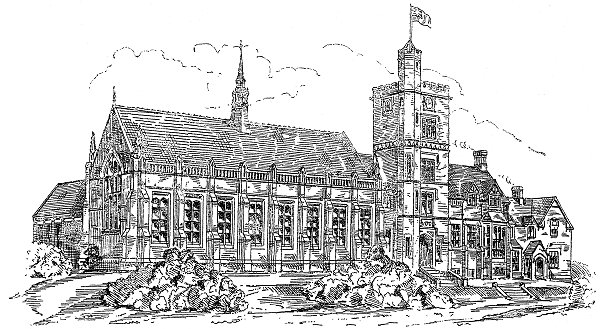
Wolverhampton Grammar School. |
 |
|
 |
Return to
the contents |
|
Proceed to
A to B |
|